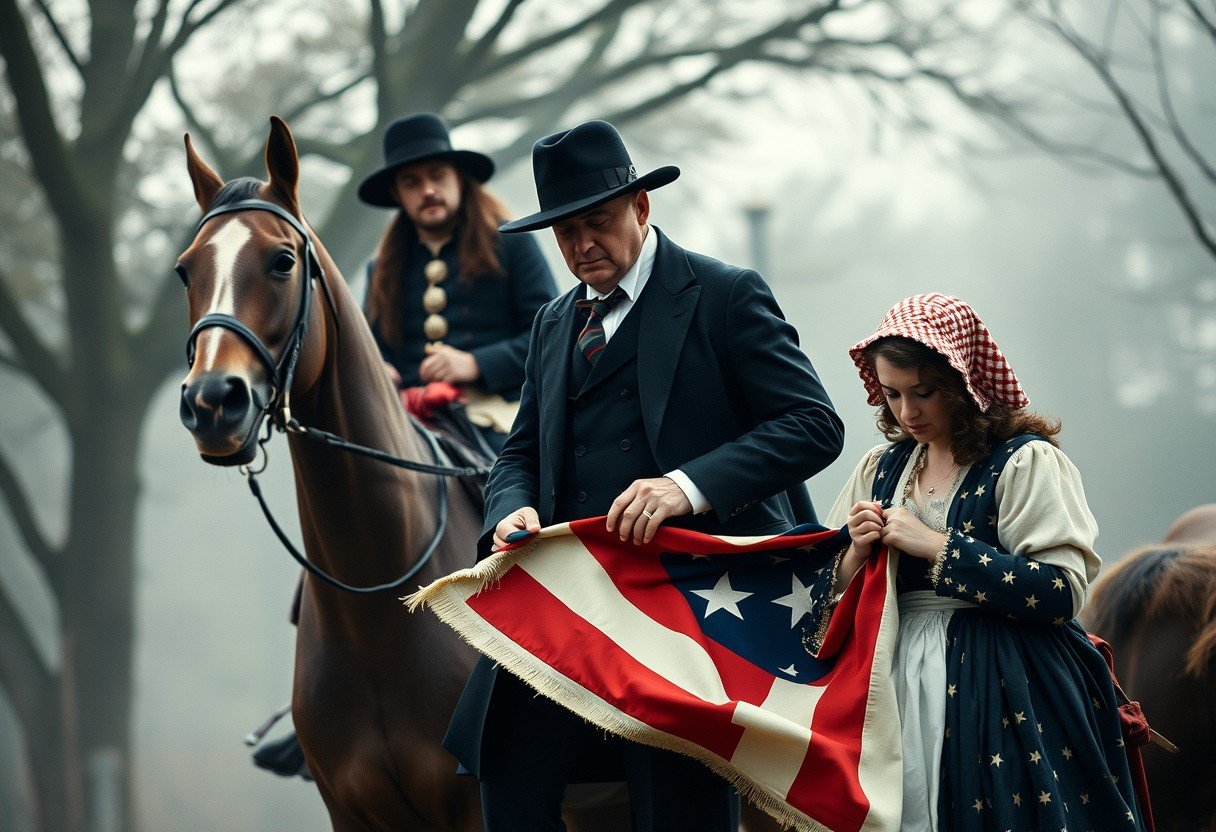There’s a fascinating thread that connects historical figures like Paul Revere, J. Edgar Hoover, and Betsy Ross, showcasing the complexities of American history. As you explore their stories, you’ll discover how each of these individuals played a pivotal role in shaping the nation, from revolutionary fervor to the foundations of modern law enforcement and the symbolism of the American flag. Understanding their contributions offers deeper insights into the fabric of your national identity and the legacies they left behind.
Icons from Different Eras of American History
Paul Revere, J. Edgar Hoover, and Betsy Ross are names that echo through the halls of American history, yet they come from very different times. Each one stepped up during a pivotal moment, leaving a mark that would define their era and influence the future of the nation.
Revere and Ross were central to the birth of the United States during the American Revolution. Their actions were fueled by a desire for independence and the creation of a new national identity. In contrast, J. Edgar Hoover rose to prominence much later, during a time when the young nation was establishing its federal institutions and grappling with modern challenges like organized crime and national security.
Their stories show how the definition of a patriot and a nation-builder has evolved over time. While one was a silversmith turned revolutionary messenger, another was a seamstress who became a national symbol, and the third was a bureaucrat who built a powerful federal agency.
| Historical Figure | Primary Era | Key Contribution | Symbolizes |
|---|---|---|---|
| Paul Revere | American Revolution (1770s) | Warned colonists of British troop movements | Courage and Alertness |
| Betsy Ross | American Revolution (1770s) | Credited with sewing the first American flag | Creativity and Nationalism |
| J. Edgar Hoover | 20th Century (1924-1972) | Shaped the FBI into a modern law enforcement agency | Law, Order, and Authority |
Their contributions highlight the diverse needs of a growing country, from the initial fight for freedom to the long-term establishment of order and security.
Symbols of Patriotism, Order and National Pride
These three figures have become more than just historical people; they are powerful symbols of American values. Each one represents a different pillar of the nation’s identity, and their stories are often told to inspire feelings of patriotism, respect for the law, and national pride.
Paul Revere’s midnight ride is the ultimate symbol of American alertness and the courage to resist tyranny. His story reminds us of the ordinary citizens who took extraordinary risks for the cause of liberty. He stands for the idea that one person’s actions can spark a revolution.
Betsy Ross, on the other hand, embodies the creative and unifying spirit of the nation. The story of her sewing the first flag gives a personal, human touch to a powerful national emblem. She represents American ingenuity and the idea that everyone has a role to play in building the country’s narrative.
J. Edgar Hoover represents the concept of law and order. As the long-serving director of the FBI, he is a symbol of the government’s role in maintaining security and justice. His legacy is a reminder of the nation’s commitment to creating a stable and safe society, even if the methods are sometimes debated.
The Legends and the Truths Behind Their Stories
As with many historical icons, the stories of Revere, Hoover, and Ross have been blended with myths over time. It’s important to separate the popular legends from the historical facts to get a clearer picture of who they really were and what they actually did.
The legend of Paul Revere often features him riding alone, shouting “The British are coming!” In reality, he was part of a larger network of riders, and his warning was likely more discreet to avoid capture. The famous phrase was popularized much later by Henry Wadsworth Longfellow’s poem, which romanticized the event for a new generation of Americans.
Similarly, the story of Betsy Ross sewing the first flag for George Washington is a cherished piece of American folklore. While she was a flag maker in Philadelphia during the Revolution, there is no definitive historical evidence from that time to prove she designed and created the very first one. The story largely comes from her grandson’s accounts decades later, highlighting how family lore can shape national memory.
J. Edgar Hoover carefully crafted his own public image as a heroic crime-fighter. While the FBI did achieve major successes under his leadership, this legend often overshadows the darker parts of his tenure, including illegal surveillance and the use of his agency to harass political opponents and civil rights leaders.
How Each Figure Faced Controversy
No historical figure is without their complexities, and Revere, Ross, and Hoover are no exceptions. Each one has faced scrutiny and controversy that challenges their heroic status, revealing a more nuanced reality. These debates show how our understanding of history is always evolving.
While their contributions are significant, the popular narratives often simplify their complicated legacies. Examining their controversies helps us understand the full context of their impact on the nation.
Here are some of the key controversies associated with each figure:
- Paul Revere: The primary controversy is not about his bravery but about the exaggeration of his role. History shows he was one of several riders that night, and he was even captured by the British before completing his mission. The myth of the lone hero overshadows the collective effort of the colonial resistance.
- Betsy Ross: The debate here centers on the authorship of the American flag. Historians have found no contemporary records to support the claim that she designed the first flag. This has led to questions about whether her story is a patriotic myth created to give the nation a female revolutionary hero.
- J. Edgar Hoover: His controversies are the most severe, involving abuses of power. Hoover used the FBI to conduct secret surveillance on American citizens, including figures like Martin Luther King Jr., and maintained confidential files to blackmail political figures, raising serious questions about civil liberties and government overreach.
These controversies remind us that our national heroes were complex human beings who operated in challenging times, and their legacies are often a mix of both admirable and questionable actions.
Their Lasting Influence on American Identity
Despite the myths and controversies, the collective influence of Paul Revere, J. Edgar Hoover, and Betsy Ross on the American identity is undeniable. They have become cultural icons whose stories are used to teach core American values like vigilance, creativity, and order.
Their legacies serve as enduring symbols of freedom and sacrifice. Revere’s ride represents the fight for independence, Ross’s flag embodies national unity, and Hoover’s complex career reflects the nation’s ongoing struggle to balance security with liberty. Together, they form a tapestry of the American experience, showing the different ways individuals have shaped the country’s destiny.
The way we remember these figures also evolves. Each generation reinterprets their stories to fit the priorities and values of the time. This ongoing dialogue with the past allows Americans to find new meaning in their legacies and helps shape our understanding of what it means to be American today.
Shared Themes That Connect Their Legacies
Though they lived in different centuries and played very different roles, the legacies of Revere, Hoover, and Ross are connected by shared themes of courage, loyalty, and dedication to a cause. Each one faced immense challenges and showed a deep commitment to their vision for America.
Revere’s ride required immense courage, Ross’s work in a time of war showed quiet determination, and Hoover’s long tenure at the FBI, for all its faults, demonstrated a fierce loyalty to his institution and his idea of national security. These themes of dedication to a greater good are what tie their stories together in the American narrative.
By studying them together, we gain a richer understanding of American history. Their combined stories show that shaping a nation requires not just revolutionary fervor but also the creation of symbols and the establishment of institutions. They prove that the American narrative is not built by one type of person but by a diverse collection of individuals whose actions continue to resonate today.
Frequently Asked Questions
What is the biggest myth about Paul Revere?
The biggest myth is that he rode alone shouting “The British are coming!” In truth, he was part of a larger alert system with multiple riders, and his warning was likely much quieter to avoid attracting attention from British patrols.
Did Betsy Ross really design the first American flag?
There is no concrete historical evidence from the Revolutionary period to confirm this popular story. While she was an active flag maker, the claim that she designed the first Stars and Stripes is based on family stories told nearly a century later.
Why is J. Edgar Hoover such a controversial figure?
J. Edgar Hoover is controversial because he used his position as FBI Director to abuse power. He authorized illegal surveillance, collected secret files on politicians and activists like Martin Luther King Jr., and used intimidation tactics, which many argue violated American civil liberties.
How do these three figures represent American values?
They each represent different aspects of American values. Paul Revere symbolizes courage and the fight for freedom. Betsy Ross embodies creativity and national unity. J. Edgar Hoover represents the value of law, order, and national security.
What is the main thing Paul Revere, J. Edgar Hoover, and Betsy Ross have in common?
The main thing they have in common is their status as pivotal figures who have profoundly shaped the American identity. Each has become a powerful symbol representing different facets of the nation’s history, from its revolutionary origins to the development of its federal institutions.






Leave a Comment